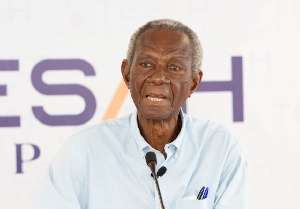The Institute of Energy Security (IES) has questioned the assumption used in establishing the new electricity tariffs by the Public Utilities Regulatory Commission (PURC) beginning February 1, 2023.
According to the IES, although it believes the rates for Cedi/Dollar exchange rate and inflation rates reflect market conditions, it considers the assumption used by the PURC on the electricity generation mix of 26.11% hydro-thermal and 73.89% thermal as baseless.
The IES in a statement said the assumption amounts to given priority to thermal power generation over hydro, given that water elevations for Bui and Akosombo generating stations (GS) have improved waterhead levels, and capable of producing over 35% of power in 2023, in its estimation.
It said data from Akosombo and Bui indicate elevations at the beginning of 2023 compared to previous are in a better position to produce more electricity than the thermals.
“Bui's water elevation is expected to help produce more megawatts to support voltage on the grid, and help reduce transmission losses if dispatched conservatively throughout the year,” the statement noted.
The Institute agreed with the expectation that bulk of the capacity generation for 2023 would come from thermal sources if natural gas supply is sustained, and planned plant maintenance schedules is strictly adhered to. However, with improved water-head levels, it said hydropower generation is estimated to produce close to 38% of 2023 capacity, should hydro-electric have dispatch priority over thermal in the generation mix.
The statement explained that “With a year-start Akosombo water level elevation of 83.10 metre (272.66 feet), it is estimated that total energy production from Akosombo GS could fall between 7,500 gigawatt-hour and 8,000 gigawatt-hour (GWh) for 2023, with the Kpong GS producing roughly 990 GWh of electric energy over the period.
“Also, Bui GS’ year-start elevation of 178.99 metres above sea level (masl) is enough to possibly produce an estimated 1,056 GWh of electricity in 2023.”
Although the IES has anticipated that the average electricity end-user tariff (GH₵/kWh) covering residential, non-residential and special load tariff electricity consumers would see an increase within the year, it said the expected increase in tariff was anticipated to be marginal should more of hydro-electric power be produce from the generation mix.
The IES is, therefore, calling on the PURC to reconsider the energy mix assumption used in the tariff adjustment (to reflect improved water-head levels) as that has an impact on the Weighted Average Cost of Gas, which has been reviewed to $6.0952/MMBtu from $5.9060MMBtu.
This, the IES believe will bring some relief to already burdened citizens, and in the face of the current economic crisis.
Business News of Wednesday, 18 January 2023
Source: classfmonline.com













